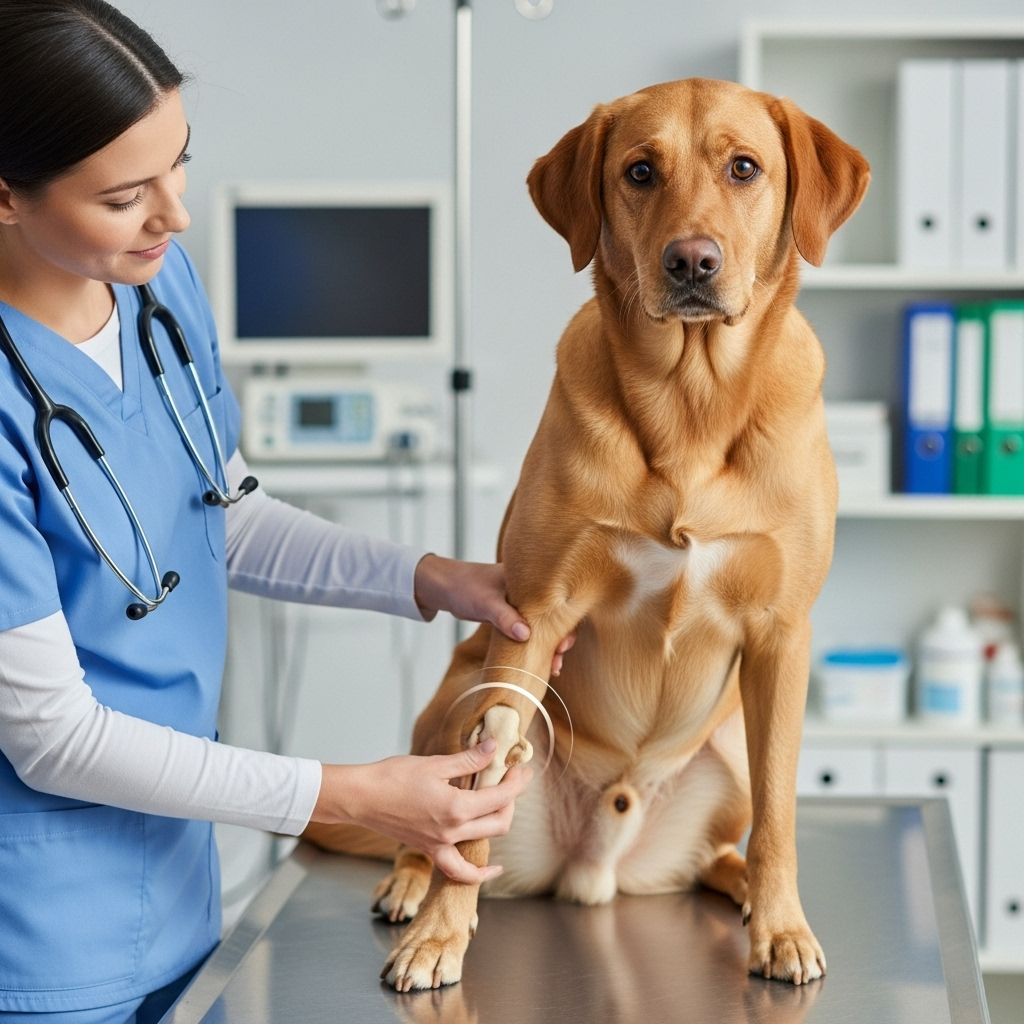Luxating Patella in Dogs: Causes, Symptoms & Effective Care
Timely intervention and targeted treatment help pets regain confidence in every step.

Luxating Patella in Dogs: Causes, Symptoms, Treatment, and Prevention
Luxating patella, commonly referred to as a dislocated kneecap, is one of the most prevalent orthopedic issues affecting dogs. This condition can range from mild and barely noticeable to severe and crippling, impacting a dog’s ability to walk, run, and enjoy life. To safeguard your companion’s well-being, it’s important for pet owners to understand the signs, causes, treatment options, and preventive strategies associated with this condition.
What Is a Luxating Patella in Dogs?
A luxating patella describes a situation where a dog’s kneecap (patella) slips out of its normal position within the groove at the bottom of the thigh bone (femur) when the knee is flexed. Instead of moving smoothly up and down, the kneecap pops to the side—medially (toward the middle of the body) or laterally (toward the outside).
Key facts:
- Affects one or both hind legs (never the front legs).
- Can be caused by inherited anatomical abnormalities or result from traumatic injury.
- Potentially painful, the condition may lead to reduced mobility or permanent lameness if left untreated.
According to veterinary experts, the condition can manifest as early as eight weeks of age, although the anatomical causes are present from birth. Luxation can also occur due to trauma, such as a fall or car accident, that stretches or tears supporting tissues around the joint.
Types of Patellar Luxation
- Medial Luxation: The kneecap dislocates toward the inside (more common in small breeds).
- Lateral Luxation: The kneecap dislocates outward (more common in large breeds and in severe, late-stage small breed cases).
What Causes Patellar Luxation?
The most common cause of patellar luxation in dogs is an inherited malformation or abnormal alignment of the bones and ligaments responsible for knee movement. Breeds with shallow femoral grooves, or those with misaligned hips, femurs, or tibias, are at increased risk. Trauma, such as accidents leading to tearing or stretching of the joint capsule, can also precipitate a luxation.
- Genetic predisposition: Seen often in toy and small dog breeds, such as Pomeranians, Chihuahuas, Yorkshire Terriers, and Poodles.
- Breeds at risk: While common in small dogs, the condition also occurs in some large breeds (e.g., Labrador Retrievers, Akitas), especially as the result of injury.
- Concurrent orthopaedic conditions: Abnormal growth or other limb deformities may increase the risk.
Symptoms of Luxating Patella in Dogs
Signs of a luxating patella can range from subtle to unmistakable. Common symptoms include:
- Sporadic limping: Intermittent lameness or sudden skipping gait, often resolving after a few steps.
- Holding the leg up: Dog momentarily lifts one hind leg or hops for a few strides.
- Reluctance to exercise: Unwillingness to run, jump, or play as usual.
- Stiff movement: Bow-legged or knock-kneed gait and reluctance to use the affected limb.
- Painful episodes: Sudden yelps or whines, sometimes observed with audible “popping” sound as the kneecap moves.
- Swelling: Inflammation around the knee joint, in some cases.
- Weakness in hindquarters: Difficulty rising or appearing unsteady, especially after rest.
Mild cases might be overlooked, especially in puppies, but over time, repeated dislocations can worsen, resulting in joint inflammation, arthritis, and permanent changes in movement.
Symptoms Table
| Symptom | Description |
|---|---|
| Intermittent Limping | Suddenly holds leg up for several steps; returns to normal gait after shaking limb |
| Skipping Gait | Dog skips or hops rather than a smooth stride |
| Reluctance to Run/Jump | Hesitates to play, run, or use stairs |
| Painful Yelps | Cries out when kneecap moves |
| Swelling | Knee joint may appear enlarged or inflamed |
How Is Luxating Patella Diagnosed?
Veterinary diagnosis involves a thorough physical exam where the veterinarian manipulates the knee to test for abnormal movement. The degree of displacement is graded on a scale from 1 (minimal) to 4 (severe):
- Grade I: Kneecap can be manually luxated but returns to position on its own.
- Grade II: Kneecap spontaneously moves out but can be manipulated back into place.
- Grade III: Kneecap is out most of the time but can be pushed back, though recurs easily.
- Grade IV: Kneecap is permanently out of place and cannot be repositioned manually.
Additional imaging—such as X-rays—may be recommended to assess bone structure, rule out other abnormalities, and plan for surgery if required.
Treatment Options for Luxating Patella in Dogs
The best treatment approach depends on the severity (grade), the dog’s symptoms, age, and overall health. A combination of medical management and surgical intervention may be required for optimal outcome.
Non-Surgical (Conservative) Management
- Weight management: Keeping your dog at an ideal weight reduces strain on the knee joint and slows progression of disease.
- Pain management: Use of anti-inflammatory medications (NSAIDs) or other pain relievers as prescribed by your veterinarian.
- Exercise restriction: Avoiding high-impact activities that trigger episodes; gentle walking is typically favored over jumping or running.
- Physical rehabilitation: Range-of-motion and strengthening exercises can help maintain joint function and muscle integrity.
- Joint supplements: Products containing glucosamine, chondroitin, or omega-3 fatty acids may support joint health and reduce inflammation.
Conservative approaches are often effective for dogs with mild lameness or low-grade luxation, particularly when symptoms are intermittent and not worsening over time.
Surgical Options
Surgery is generally recommended for dogs with persistent lameness, higher-grade luxation, or those at risk for secondary joint damage (like arthritis or ligament tears).
Common procedures include:
- Tibial tuberosity transposition: Moving the patellar ligament’s attachment to correct its alignment.
- Trochleoplasty: Deepening the femoral groove to better house the kneecap.
- Soft tissue realignment: Tightening loose tissues and releasing overly tight ones to stabilize the patella.
Surgical prognosis is generally good, especially in young or otherwise healthy dogs. Post-operative management is essential and usually includes rest, restricted activity, and rehabilitation exercises to restore function and strength.
Recovery Outlook and Prognosis
- Most dogs recover well: Especially those that receive timely surgical intervention for higher-grade luxation.
- Physical therapy: Aids in restoring limb strength and function post-surgery, reducing the risk of recurrence.
- Long-term care: Weight management, ongoing exercise plans, and regular veterinary monitoring help maintain outcomes and reduce risk of complications such as arthritis and cruciate ligament injury.
Preventing Luxating Patella in Dogs
Although inherited anatomical factors cannot be corrected without surgery, you can lower your dog’s risk of developing complications from luxating patella by:
- Maintaining an ideal body weight to minimize stress on joints.
- Careful breeding: If you are a breeder, avoid breeding dogs known to have patellar luxation or those with a family history of the condition.
- Avoiding high-impact or risky activities that could cause orthopedic injury, especially in vulnerable breeds.
- Monitoring and modifying activity based on your veterinarian’s recommendations if your dog is at risk.
Routine veterinary examinations, especially in growing puppies and at-risk breeds, support early detection and timely intervention should symptoms arise.
Frequently Asked Questions (FAQs)
What breeds are most at risk for luxating patella?
Toy and small breed dogs—such as Pomeranians, Chihuahuas, Yorkshire Terriers, Poodles, and French Bulldogs—are most commonly affected, though some large breeds like Labrador Retrievers may also be at risk.
Will my dog always need surgery?
Not all cases require surgery. Many mild cases (Grade I or II) can be managed with conservative treatment, weight control, and restricted activity. Surgery is more often recommended for persistent symptoms or higher-grade luxation to prevent arthritis and chronic lameness.
Can a dog live a normal life with a luxating patella?
Most dogs with milder grades and proper management go on to live happy, active lives. In severe or untreated cases, permanent lameness and arthritis can occur if not appropriately addressed.
Is luxating patella preventable?
While anatomical predispositions cannot be entirely prevented, maintaining healthy weight, responsible breeding, and avoiding accidents can minimize both the risk and severity of luxating patella and its complications.
How soon should I see a veterinarian if I suspect my dog has this condition?
Prompt veterinary evaluation is essential if your dog is limping, favors a hind leg, or demonstrates pain during movement. Early intervention improves outcomes, especially with higher-grade luxation or if the dog is showing signs of distress.
Key Takeaways
- Luxating patella is a common orthopedic knee issue, particularly in small breed dogs, manifesting as limping, skipping, or reluctance to run or jump.
- Diagnosis is by physical exam and grading system (1-4); imaging may be needed for surgical planning.
- Treatment includes weight management, pain relief, physical therapy, lifestyle adjustments, and, for severe cases, surgery.
- Early detection and management help prevent long-term complications and support optimal quality of life for affected dogs.
References
- https://www.purina.com/articles/dog/health/symptoms/luxating-patella-in-dogs
- https://www.vet.cornell.edu/departments-centers-and-institutes/riney-canine-health-center/canine-health-information/patellar-luxation
- https://www.akc.org/expert-advice/health/luxating-patella-dog/
- https://bondvet.com/b/luxating-patella-dog
- https://vcahospitals.com/know-your-pet/luxating-patella-in-dogs
Read full bio of Srija Burman












